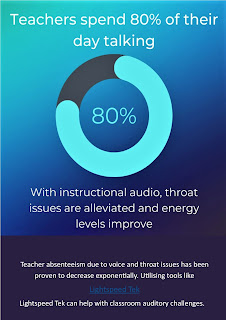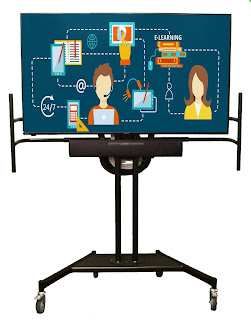Your Voice is Important
4 Minute Read
How can I be
heard?
The
plain truth is if you’re looking to project your voice in a teaching/training
environment then over time it's highly likely you will strain
your voice. Yes, modern buildings have great acoustic design compared to ten
years ago, but acoustic architecture is only a small part of being heard.
In
a modern learning/ training environment, the size of the space has increased,
or the capacity of students has. So how do you project your voice to many
without strain?
Types of
Voice amplification
In
an environment like a hall or theatre box, linear or ceiling speakers would
generally be used, and are permanently set up to accommodate multiple users.
Depending on the size of the environment speaker placement is key to being
heard and can be an expensive exercise to get it just right.
What about an
ILS or Training space?
The
above scenarios are just not viable in spaces that change in configuration a
lot. These rooms tend to have a lower ceiling as well, so a conventional
speaker system is only going to project volume at a defined angle and depth. This
causes anyone in front of the speakers to get blasted while students at the
back find it difficult to hear.
What’s the
answer?
Lightspeed Voice reinforcement
systems deliver optimum speech intelligibility, overcome classroom/ training
room ambient noise and provide crystal clear sound to all your students
regardless of where they may be seated or where the teacher may be standing.
Adding
voice
reinforcement not only allows teacher/trainers to talk at a lower volume so as
not to strain their voice and reach every student no matter where they are
relative to the teacher's position in the room, this means students get to hear
intelligible voice instructions, keeping them on task, attentive and minimising
student redirection.
How does it
work?
The Lightspeed Hybrid Speaker is a
combination flat panel and cone speaker which is designed to saturate the room
with sound. The flat-panel speaker is different from a conventional cone
type-speaker, which is very directional. The hybrid speaker disperses sound
with random sound vectors from the surface of the speaker in nearly a 180°
radius saturating the room with sound and creating an even sound pressure level
(SPL). Lightspeed's unique cross-over technology allows them to also
incorporate a cone speaker for the full range of sound that today's multimedia
classrooms need.
What about the microphones?
The small (Flexmike) neck lanyard
microphone gives the user the ability to mute or increase/decrease the volume
and includes a 3.5 mm input to connect another device ie. Laptop, iPad, Andriod
tablet. The Flexmike also include a mic jack for adding an over the ear microphone
that suits this type of connection.
Another option for a microphone is
a Sharemike and the name pretty much describes its use, these microphones are
for handing around an audience.
Both Microphones work on a
Radiofrequency signal, this type of signal is highly stable and not affected by
obstacles or windows. When you’re finished just dock them in the charger and
they are ready for another 4-6 hours.
Why choose
lightspeed?
“Young
children spend 75% of their school day involved in listening activities.
Their primary channel for learning is hearing.”
Sitech
Systems NZ ltd is a New Zealand distributor, we have been selling this product
for over 20 years, with a five-year warranty on hardware excellent
functionality, expandability, and simplicity of installation Lightspeed are the
leader in educational environments. The benefits of Lightspeed
All
the lightspeed voice reinforcement range include the ability to connect ASLD
(assisted listening devices) for a student that has hearing impairments.
How are they
installed?
These
Lightspeed dual hybrid speaker units are designed to be installed into
suspended ceilings. Or if no ceiling tiles, then a fitted surround is added to
fit onto a wall or ceiling.
The
controller/media connector is best fitted into a side cupboard or on a shelf
where if required, you can adjust external volumes i.e., a Bluetooth adaptor or
where microphone volumes can be adjusted. Another option in an installation
that cannot add cabling is to use the Topcat unit this only requires a power
GPO for connection.
What
types of Lightspeed voice reinforcement units are there?
There
are four main types of voice reinforcement depending on the type of learning or
environment size.
1.
lightspeed
Topcat Only requires power otherwise completely wireless.
2.
Lightspeed TCQ
and 955
Access A wired version of the above designed for renovations or new
builds.
3.
POD
system Used with learning groups combined with a Topcat or TCQ.
4.
Redcat Designed
for single-cell environments can include a battery for off-grid learning or
mobile trainers.
Key
points
1.
*Young
children spend 75% of their school day involved in listening activities. Their
primary channel for learning is hearing.
2.
*ESOL
children. With the acknowledgement of English language acquisition as a primary
goal, phonemic awareness and word recognition is critical to their ongoing
academic success
3.
*Auditory facilities are not fully developed until around the age
of 15
4.
*Classroom
audio is a proven tool that can overcome adverse classroom conditions,
providing students with enhanced speech recognition and, therefore, a
much-improved opportunity to learn. Sound-field classroom audio is now
recognized as one of the most powerful and cost-effective tools for student
improvement.
5.
*Sound-field
improves learning and literacy outcomes, creates enhanced classroom harmony and
improved student behaviour, and reduces voice strain among teachers.
Sound-field achieves this by overcoming problems associated with noise,
distance, and reverberation.
New
Zealand completes its study
The first
study of its kind in New Zealand has found more than
half of teachers surveyed have suffered from voice problems, ranging from
hoarseness to total loss, during their careers.
The findings of a nationwide survey of 1879 primary
and secondary school teachers, led by the University of Auckland researchers
and published this week, has prompted calls for more awareness around what has
been described as an overlooked and potentially damaging health risk. Of the
1081 teachers who reported any voice problems, just over half told of mild
problems, while 36 per cent reported "moderate" problems and nearly
11 per cent had experienced severe or very severe issues.
Just over 70 per cent answered that their voice took less than a week to recover from problems, while 22 per cent took up to four weeks and a further 7 per cent reported chronic problems that required at least four weeks of recovery.
· The Schematic below Fig: 5 shows four TCQ hybrid speakers one in each
teaching space. Each with a Flexmike, then two of the teaching spaces have a
share mike that between those two rooms for larger group instruction. Lastly,
there is a single Share mike connected through a Multi mike for “call all”
between all four teaching spaces and includes a Bluetooth receiver for wireless
device audio distribution.
What
next?
In most instances, I would say 90% of the time when trialling these
systems in a working environment, they are purchased. The proof in Lightspeed
voice reinforcement is in getting Lightspeed working in a situation they are
designed for. Once they have been used for a few days to a week the proof is in
the pudding.
Why not book a trial and see for yourself.









Comments
Post a Comment